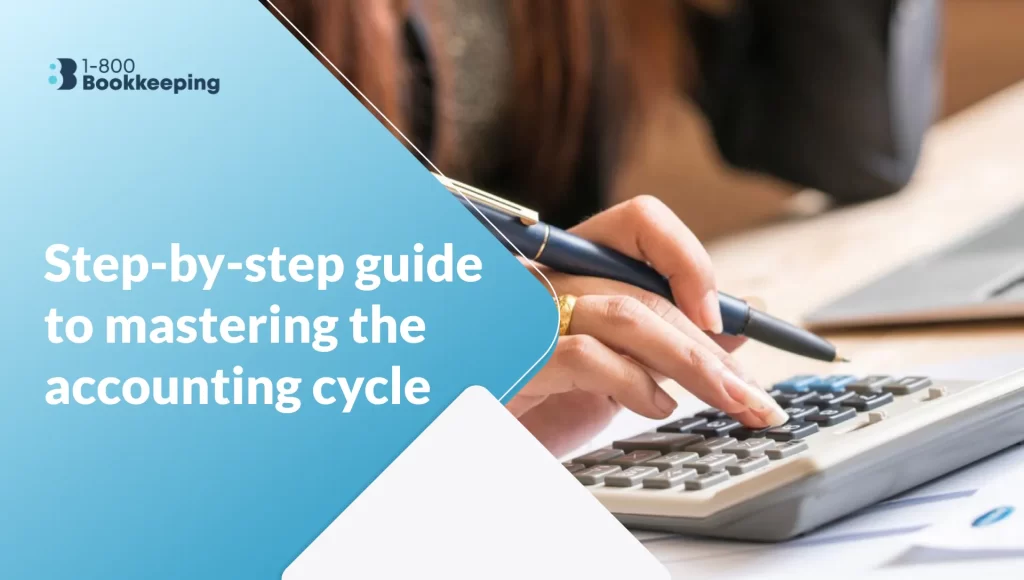This guide offers a thorough walk-through of the first half of the eight essential steps in the accounting cycle. You’ll see how each stage works and why it matters for the day-to-day management of your business. This is Part 1 of a two-part blog series. If you want to learn more after you finish these steps, keep reading Part 2 for a deeper look at adjusting entries, preparing adjusted trial balances, generating financial statements, and closing the books.
Understanding the Accounting Cycle
The accounting cycle holds the key to clear financial reporting and better decision-making. It follows steps that track every monetary action from start to finish. Following this cycle allows you to see which operations drive revenue, identify areas of cost, and maintain accuracy in your financial records.
What is the Accounting Cycle?
The accounting cycle is a systematic series of steps businesses follow in recording, classifying, and summarizing financial transactions. It starts when you first spot a transaction and ends when you close the books. This cycle runs during each financial reporting period, such as a month, quarter, or year.
The cycle relies on consistency and routine. Each new period begins with a fresh set of records, which flow naturally from the final steps of the previous cycle. Because of its repetitive nature, the accounting cycle can become second nature once you master each step.
Why is the Accounting Cycle Important for Businesses?
The accounting cycle provides a clear roadmap for tracking money flow in and out of a business. When you follow it meticulously, you can:
- Ensure accurate financial reporting.
- Detect mistakes in calculations or data entry early.
- Make decisions based on actual numbers rather than guesses.
- Build a strong foundation for tax filings and audits.
It also helps owners, managers, and investors see how a business performs over time. By repeating the same steps each period, you can compare performance from one month or quarter to another and spot trends that deserve attention.
Overview of the 8 Essential Steps
The entire accounting cycle includes eight significant steps:
- Identifying Financial Transactions
- Recording Transactions in the Journal
- Posting to the General Ledger
- Preparing the Unadjusted Trial Balance
- Making Adjusting Entries
- Preparing the Adjusted Trial Balance
- Generating Financial Statements
- Closing the Books
This Part 1 blog covers the first four steps: identifying financial transactions, recording them, posting them to the ledger, and preparing the unadjusted trial balance. Part 2 will walk through the final four steps, which complete the cycle.
Preparing for the Accounting Cycle
A solid plan makes the entire cycle smoother. Preparations include setting up the right accounting system, gathering documents you’ll use repeatedly, and finding tools that make record-keeping easier.
Setting Up Your Accounting System
Your accounting system can be manual or digital, but it should always be organized. Even if you’re a solo entrepreneur, it pays off to be methodical:
- Chart of accounts: Create a list of categories for assets, liabilities, equity, revenue, and expenses. This ensures each transaction fits into the right place.
- Choosing between cash or accrual: Decide whether to record transactions when cash moves (cash basis) or when the transaction occurs (accrual basis). Most businesses use accrual for more accurate insights.
- Establishing procedures: Outline how you’ll handle purchases, sales, payroll, and other recurring activities.
Some businesses use bookkeeping software such as QuickBooks or Xero. Others choose spreadsheets or a simple paper-based approach. The method doesn’t matter as much as consistency.
Identifying Key Financial Documents
Collect and store the source documents you’ll rely on throughout the cycle. These may include:
- Sales invoices from customers.
- Purchase receipts or vendor invoices.
- Bank statements that show deposits and withdrawals.
- Credit card statements for company card usage.
- Payroll records for wages and salaries.
Keep these documents in good order. Some business owners store digital copies in cloud-based systems. Others keep a well-labeled binder or file folders on a shelf. Whichever you choose, make it easy to pull any document you need when recording and verifying transactions.
Tools and Technology for Streamlining the Process
Several tech solutions help you track the accounting cycle with minimal hassle:
- Accounting software: Automates repetitive tasks like posting journal entries and generating financial statements.
- Receipt capture apps: Turn paper receipts into digital entries.
- Bank feeds: Link your bank accounts to accounting software so that deposits and withdrawals feed into your system in near-real time.
- Mobile apps: Let you log expenses on the go.
As your business expands, these tools become more valuable because they free you from tedious data entry. You can invest that time in growing your operations. Many accounting programs also offer built-in checks and balances that reduce errors.
Get Complete Control Over Your Accounting Cycle with 1-800 Bookkeeping
At 1-800 Bookkeeping, we understand that mastering the accounting cycle can be daunting, especially when juggling the daily demands of running a business. That’s why we’re here to make it easier. Our team of experienced bookkeepers specializes in simplifying each step, from identifying financial transactions to preparing the unadjusted trial balance, so you can focus on growing your business.
With our services, you don’t have to worry about tracking every transaction, posting to the general ledger, or preparing accurate trial balances. We use cutting-edge accounting software and proven processes to ensure your books are always balanced and compliant with financial regulations. Whether you’re a small business owner or managing a growing enterprise, we tailor our solutions to fit your unique needs.
By partnering with 1-800 Bookkeeping, you gain a team that treats your financial records with the same care and precision as ours. We don’t just keep your books in order—we help you understand the numbers behind your business, empowering you to make smarter decisions.
If you’re ready to streamline your accounting cycle, let’s talk. Reach out to us today and see how we can help simplify your bookkeeping process, one step at a time.
Step 1: Identifying Financial Transactions
Step 1 is where you pinpoint every transaction that affects your business’s finances. Missing transactions can confuse later, so give this stage the attention it deserves.
What Qualifies as a Financial Transaction?
A financial transaction is an event that changes the monetary value of a business’s accounts. These can be:
- Sales: Cash or credit transactions for products and services.
- Purchases: Supplies, inventory, or other expenses.
- Payments: Outflows of cash to vendors or employees.
- Receipts: Inflows of money, such as when a customer pays you.
- Adjustments: Changes in asset values, like depreciation or accruals (though these come later in the cycle).
Every time your business’s financial position changes, that’s a transaction. Identify it, classify it, and ensure you have a reliable document or digital record proving it happened.
Examples of Common Business Transactions
Small and medium-sized businesses see transactions like:
- Customer sales: A local bakery sells a batch of pastries to a customer and receives payment in cash or by credit card.
- Vendor purchases: The bakery buys flour, sugar, and eggs from a wholesaler and pays by check or online transfer.
- Payroll: The bakery pays employees every two weeks. This includes wages, tax withholdings, and benefits.
- Utilities: Monthly bills for water, electricity, and internet.
- Loan payments: Principal and interest to the bank.
Each transaction must be tracked accurately. Poorly tracked expenses or missed income can lead to trouble when you prepare your financial statements or file taxes.
Organizing Source Documents for Accuracy
Keep your source documents in a central location. Using digital software, set up folders by transaction type or month. If you keep physical documents, label each folder clearly (e.g., “Sales Invoices – July 2025,” “Purchases – July 2025”). This makes it easier to:
- Reference the original details when writing journal entries.
- Confirm the accuracy of each entry if you have questions.
- Handle audits or tax reviews if those come up.
Organizing source documents supports a well-run accounting cycle. When it’s time to record transactions, everything is at your fingertips.
Step 2: Recording Transactions in the Journal
After identifying a financial transaction, it’s time to put it on the record. The journal, sometimes called the “book of original entries,” captures the date, accounts involved, and amounts for every transaction.
Understanding Journal Entries
A journal entry includes:
- Date of the transaction.
- Account(s) debited along with the debit amount.
- Account(s) credited along with the credit amount.
- Brief description summarizing the transaction.
Debits go on the left, and credits go on the right, and total debits always equal total credits. This equality underpins the double-entry bookkeeping system and keeps the balance sheet accurate.
Active Voice Example:
You record a debit to “Office Supplies Expense” and a credit to “Cash” to show you spent company funds on office supplies.
Best Practices for Accurate Recording
- Use precise account names: Follow your chart of accounts so you don’t confuse “Office Supplies” with “Inventory.”
- Double-check amounts: Match them to your source document or receipt.
- Stay chronological: Write entries in order. This simplifies historical reference.
- Include a short memo: Detail what happened, such as “Sold 10 units of product X on credit.”
- Automate when possible: Accounting software can post transactions from integrated bank feeds or point-of-sale systems.
Staying consistent ensures your ledger reflects reality.
Examples of Debit and Credit Entries
- Sale of merchandise for cash
- Debit: Cash
- Credit: Sales Revenue
- Memo: Sold goods for immediate payment.
- Purchase of office supplies for cash
- Debit: Office Supplies Expense
- Credit: Cash
- Memo: I bought copy paper and pens.
- The customer pays on a credit account
- Debit: Cash
- Credit: Accounts Receivable
- Memo: Received payment from a customer.
In each example, the debit entry adds value to one side of the ledger, and the credit entry deducts value from another (or vice versa, depending on the account type).
Step 3: Posting to the General Ledger
Now that transactions have been recorded in the journal move them to the general ledger. The ledger collects all the transactions for each account in one place, giving you the big-picture balance of each category.
What is the General Ledger?
The general ledger is the central repository for every account in your chart of accounts. It shows each account’s current balance and the detailed transactions that contributed to that balance.
- Assets: Cash, Accounts Receivable, Equipment.
- Liabilities: Accounts Payable, Loans, Accrued Expenses.
- Equity: Owner’s Capital, Retained Earnings.
- Revenue: Sales, Service Income.
- Expenses: Rent, Utilities, Office Supplies.
When you post a journal entry to the ledger, you transfer debits and credits to the respective account ledgers so you can track the impact on each account’s balance.
Importance of Accurate Ledger Posting
Each entry in the general ledger affects your financial statements. If you post a debit to the wrong account or skip a transaction, your financial reports will be off. That can lead to:
- Misstated profits.
- Cash flow miscalculations.
- Confusion when paying taxes.
By updating the ledger accurately, you ensure your trial balance and resulting statements reflect the accurate financial picture.
Common Errors to Avoid
- Forgetting to post an entry: This happens when you write a transaction in the journal but never carry it into the ledger.
- Posting to the wrong account: Double-check account names, especially if they sound similar.
- Misplacing digits: A small typo can cause significant discrepancies.
- Skipping the date field: Dates matter because they connect transactions to specific reporting periods.
Many accounting software programs handle much of this automatically, but it’s wise to confirm the software’s postings match your expectations.
Step 4: Preparing the Unadjusted Trial Balance
You’ve recorded transactions in your journal and then posted them to the ledger. The unadjusted trial balance is your first chance to see if the accounts are still balanced before you adjust the entries.
What is an Unadjusted Trial Balance?
The unadjusted trial balance is a report that lists all account balances from the ledger. It shows the debit or credit totals for each account. The primary purpose is to check whether total debits match total credits.
Active Voice Example:
You compile each account’s balance to confirm that your system remains balanced.
Verifying the Accuracy of Account Balances
Check these key points in your unadjusted trial balance:
- Debit equals Credit: If these totals match, your books are balanced from a technical standpoint.
- No significant discrepancies: Look for unusually large or small balances.
- All accounts are present: Ensure you haven’t missed an account.
- Cross-reference with bank statements: Sometimes, a quick peek at your bank balance helps confirm if the cash account looks correct.
A matching total of debits and credits doesn’t guarantee that each transaction is perfect, but it does show your overall entries are in balance.
How to Spot and Correct Errors
- Look for transposed digits: Swapping digits (e.g., 54 instead of 45) can throw off balances.
- Review suspicious totals: Investigate if an account has a balance that makes little sense.
- Trace questionable entries back to the journal: Confirm they were recorded correctly.
- Adjust immediately: Make a correcting journal entry if you find mistakes.
If you find and correct entries, run a new unadjusted trial balance so the final numbers reflect accurate balances.
What to Expect in Part 2
Congratulations on making it through the first four steps. Part 2 picks up where we left off. It discusses adjusting entries, preparing an adjusted trial balance, creating financial statements, and closing the books. Here’s a quick preview:
Adjusting Entries and Preparing Adjusted Trial Balances
Not every transaction is straightforward. Accruals, deferrals, and depreciation all enter the picture when adjusting entries. Adjusting these entries allows you to account for expenses and revenues that fall between periods. After you record them, you prepare the adjusted trial balance, which includes these newly updated figures.
Generating Financial Statements
The adjusted trial balance forms the basis for your core financial statements:
- Income Statement: Shows revenue, expenses, and profit or loss.
- Balance Sheet: Summarizes assets, liabilities, and equity at a point in time.
- Statement of Cash Flows: Tracks incoming and outgoing cash from operations, investments, and financing activities.
These documents inform investors, lenders, and decision-makers about your financial standing. They can also shine a spotlight on areas that need attention and resources.
Closing the Books and Beyond
Finally, you’ll learn how to close the books, which involves zeroing out temporary accounts (revenues and expenses) and transferring their balances to retained earnings or owner’s equity. Closing the books signals the end of one accounting cycle and the start of the next.
In Part 2, you’ll discover detailed tips for making these final steps seamless. You’ll also see how to set yourself up for the next cycle so you can keep building on strong financials.
Conclusion and Call to Action
You’ve seen how the first four steps of the accounting cycle form the backbone of accurate bookkeeping. From identifying transactions to preparing the unadjusted trial balance, each stage feeds the next. Keep these fundamentals in mind so your financial records remain in tip-top shape.
Part 2 will explain the final steps: adjusting entries, creating your financial statements, and closing the books. Once you master both halves of the cycle, you’ll have a dependable, repeatable process that keeps your finances in order and your business running smoothly.
Curious about the next steps in fine-tuning your financial record-keeping? Keep reading to Part 2. You’ll gain clarity on adjusting entries in financial statements and how to wrap up an entire accounting period confidently. Consider exploring modern accounting software if you’re looking for even more ways to maintain solid records. These tools automate the process, saving you time and improving accuracy.
Take your bookkeeping skills to new heights. With the proper methods and resources, you can manage your business finances with clarity and efficiency. And remember: a well-managed accounting cycle sets the stage for informed decisions and growth. You’re already halfway there—stay tuned for Part 2.
Feeling Overwhelmed by Bookkeeping? We Can Help.
Running a business is demanding, and keeping track of your finances can be a never-ending chore. Many business owners need help with the complexities of bookkeeping, which can leave them frustrated and behind.
1-800 Bookkeeping offers expert services to streamline your financial processes and empower you to make informed decisions.
Our team of seasoned professionals understands the unique challenges businesses of all sizes face. We can help you:
- Free Up Valuable Time: Offload your bookkeeping tasks to our dedicated professionals.
- Gain Peace of Mind: Ensure your financial records are accurate and up-to-date.
- Make Smarter Decisions: Get actionable insights into your business performance through clear and concise reports.
- Feel Confident: Make informed financial decisions based on reliable data.
Don’t let bookkeeping hold you back from achieving your business goals. Contact 1-800 Bookkeeping today for affordable bookkeeping solutions.
Frequently Asked Questions
Below are some common questions and answers from real-world queries that people often search for when they explore how to master the accounting cycle. These FAQs focus on crucial details that often come up for business owners, bookkeepers, and students.
- Question: How often should I complete the accounting cycle?
Answer: Most businesses repeat it monthly or quarterly. The choice depends on your reporting needs. Monthly cycles provide timely insights, while quarterly cycles reduce the workload if you have fewer transactions. - Question: Do I have to follow all eight steps in the accounting cycle?
Answer: Yes. Each step serves a specific purpose. Skipping a step risks inaccurate financial data. The steps link together, and leaving one out can cause confusion later. - Question: What if my debits and credits don’t match in the unadjusted trial balance?
Answer: That indicates a posting or arithmetic error. Review your journal entries and ledger postings, and correct any mistakes. A balanced trial balance is essential for accurate statements. - Question: Is there a difference between a journal and a ledger?
Answer: Yes. The journal is the initial place where transactions get recorded in chronological order. The ledger organizes that information by account, letting you see each account’s total balance over time.
Question: Can I use spreadsheets instead of accounting software?
Answer: You can, especially if you have a smaller volume of transactions. Spreadsheets offer flexibility and are often cheaper. However, you must pay close attention to data entry and formulas to avoid errors.





